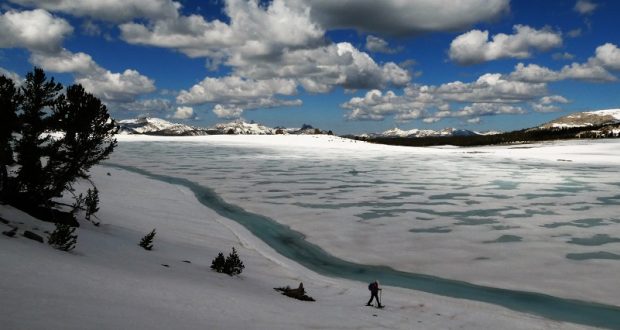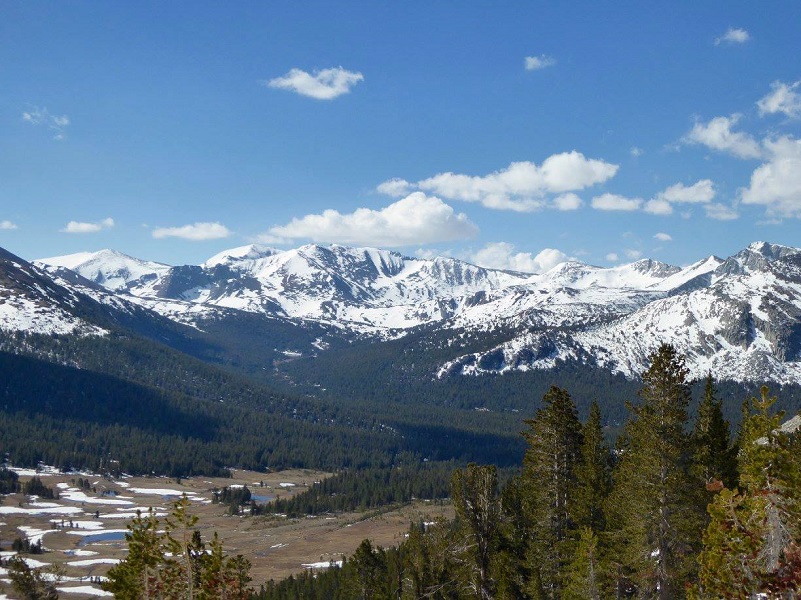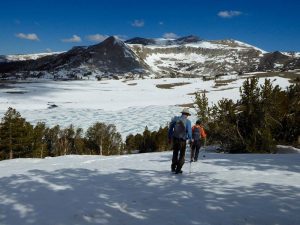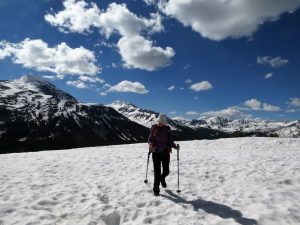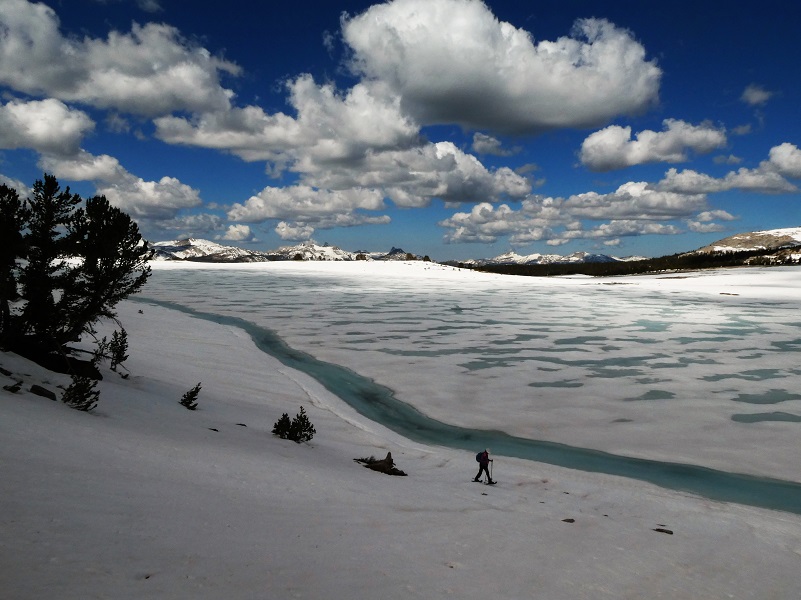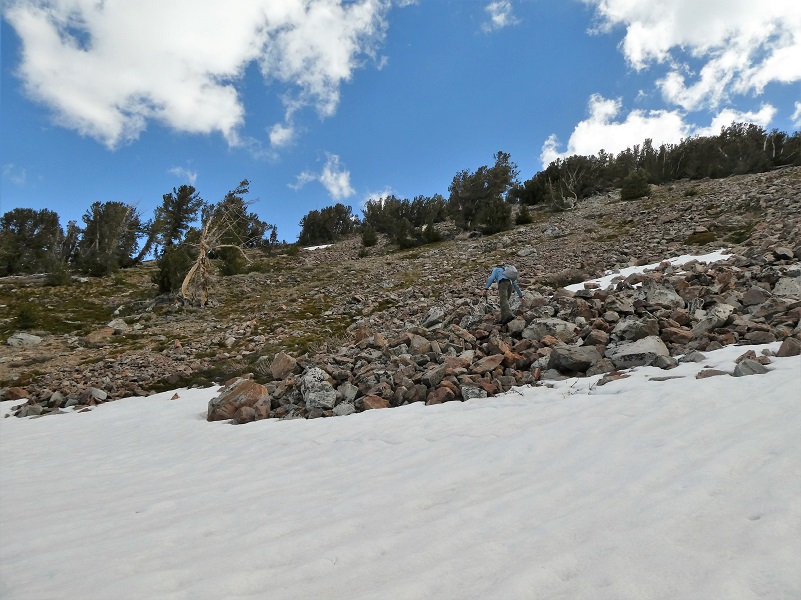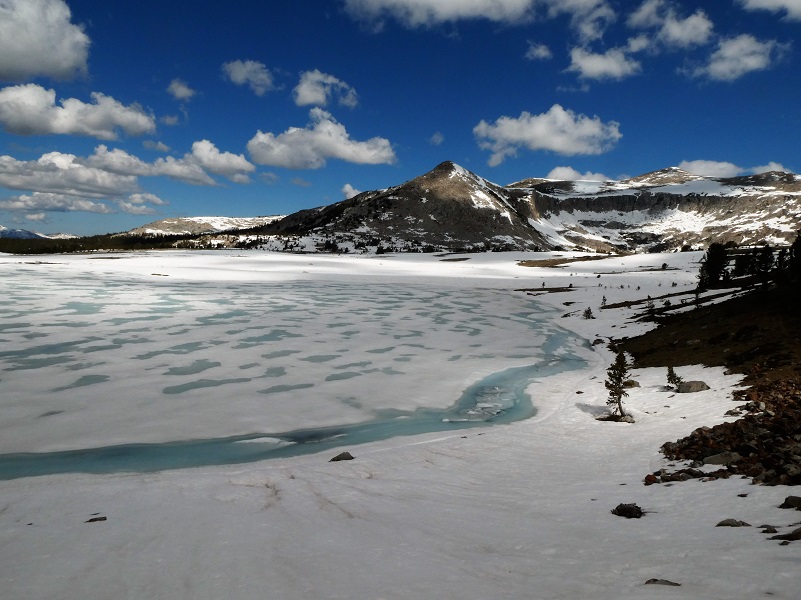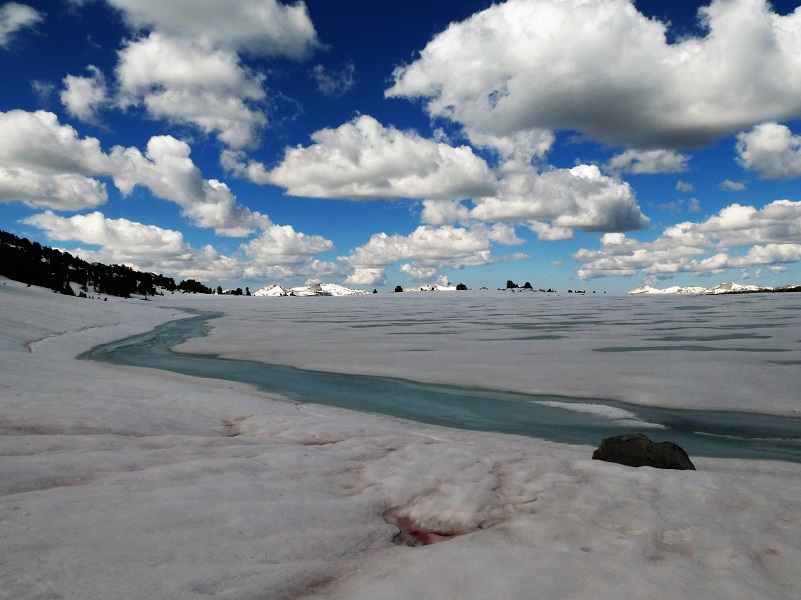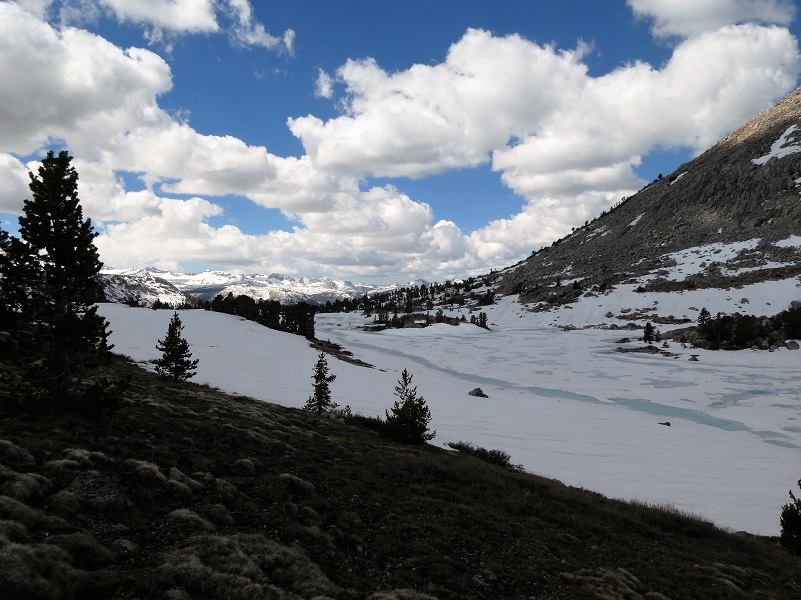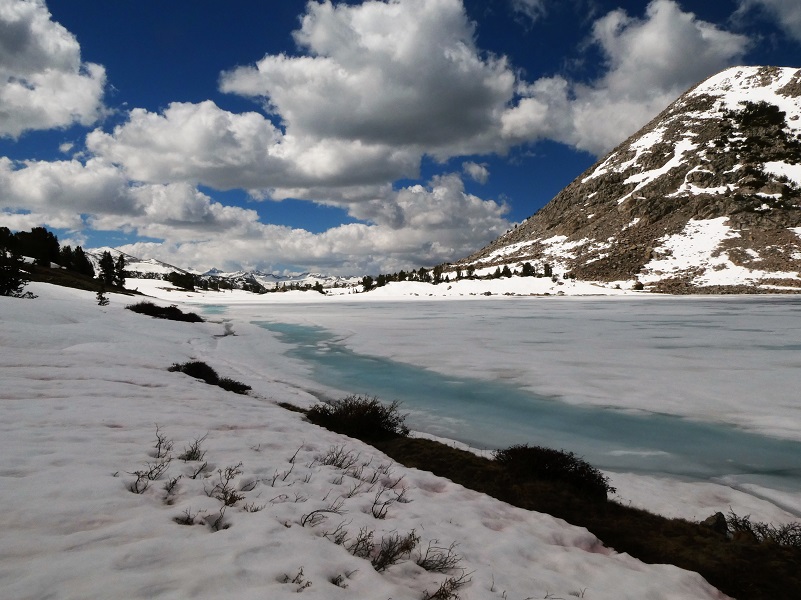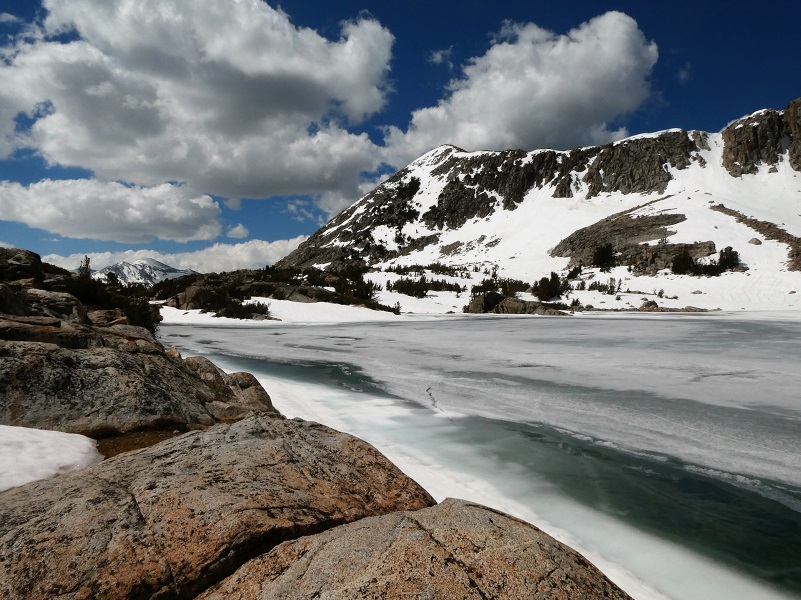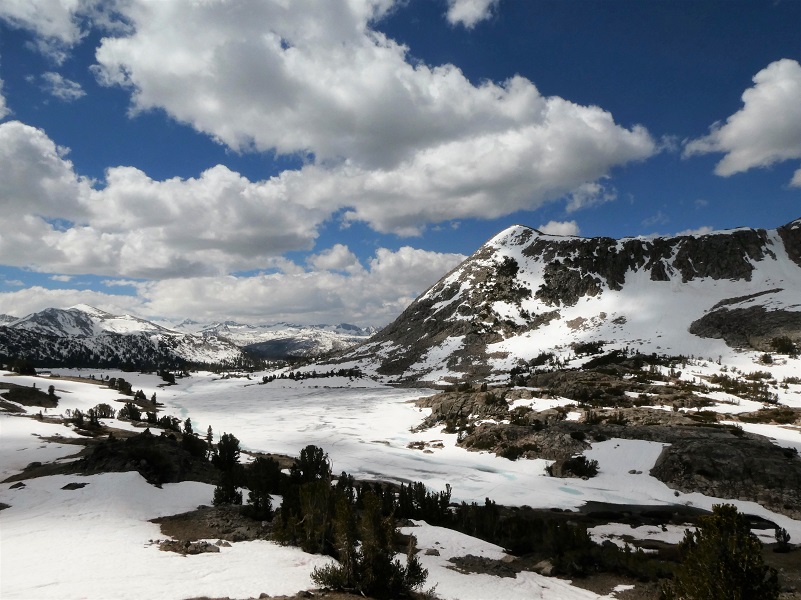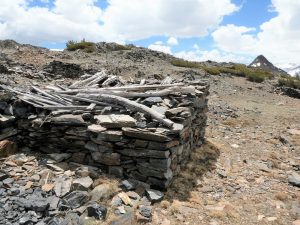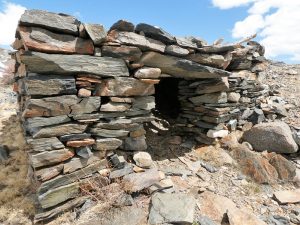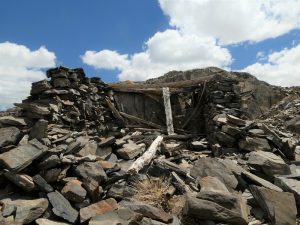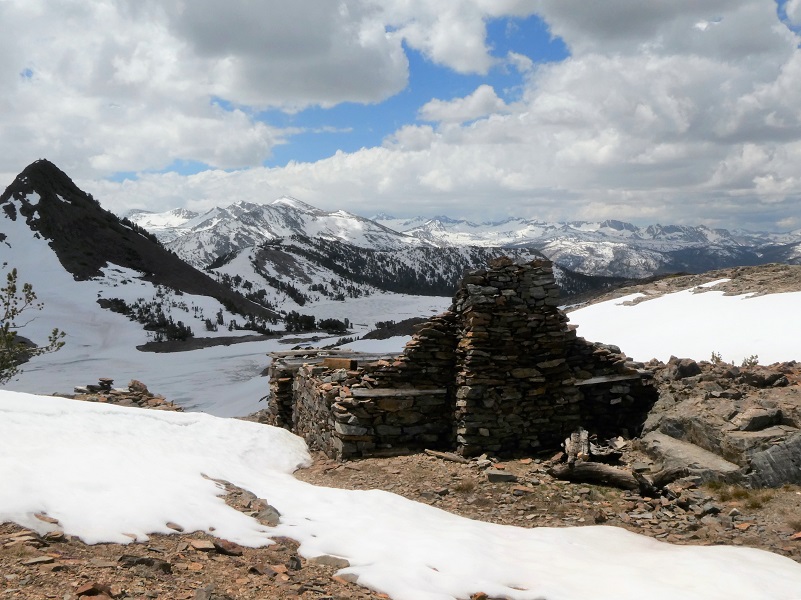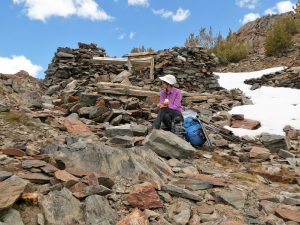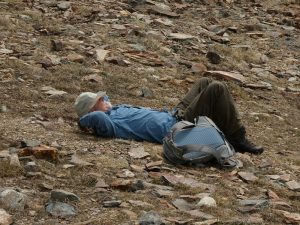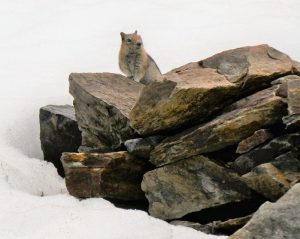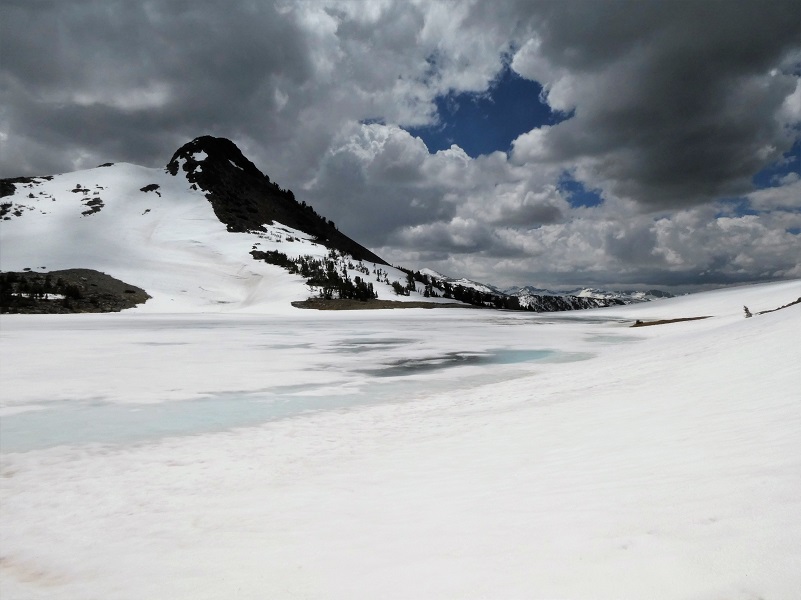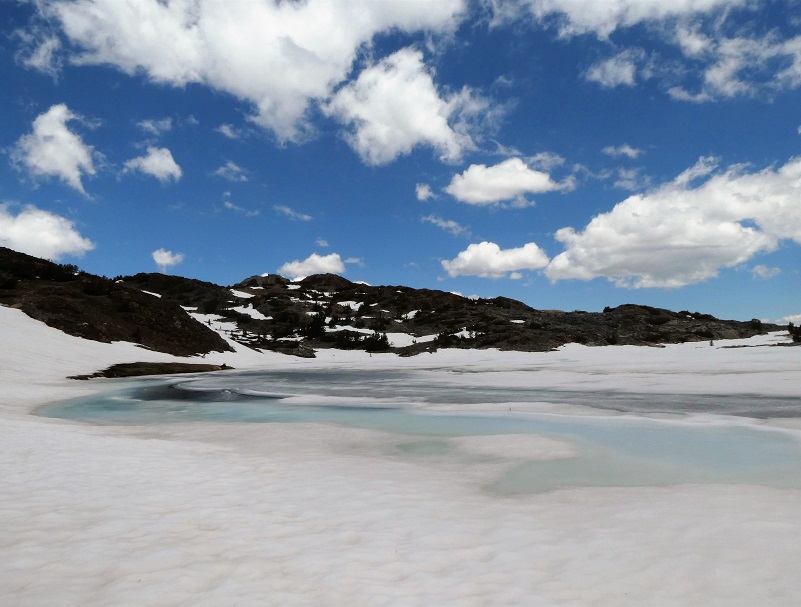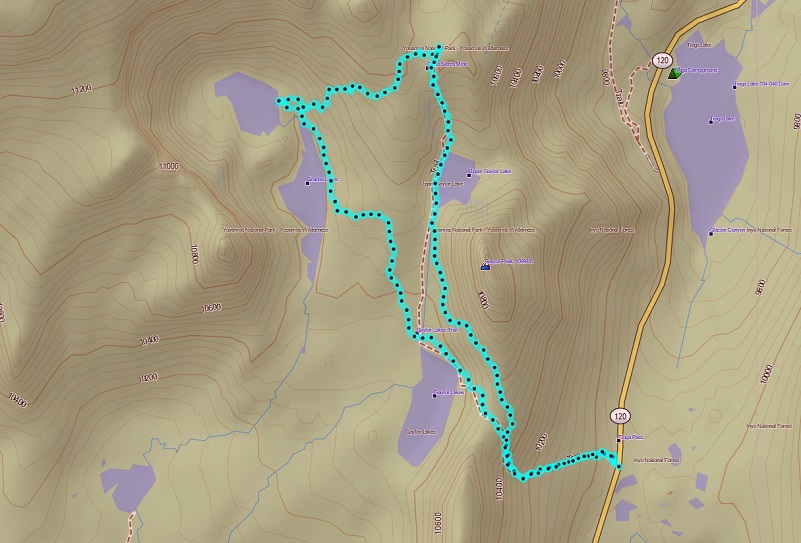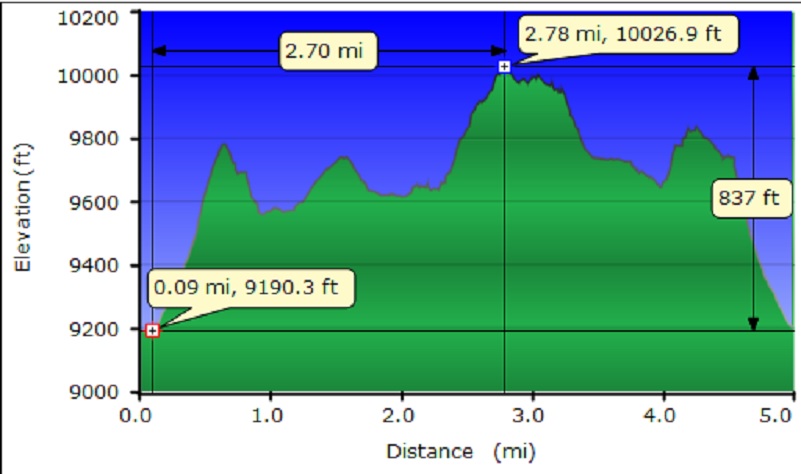Some of us snowshoed, some of us hiked and all of us postholed and sank through the spring snow on our way up to beautiful frozen lakes in the Tioga Pass area with blue sky and white puffy clouds to add some sparkly to the day.
Where: Yosemite National Park, Inyo National Forest
Distance: 4.98 Miles
Difficulty: Moderate
Elevation Range: 9,938′ – 10,817′
Date: May 29, 2018
Map: Falls Ridge Quad
Dog Hike? No
We parked our car at the parking lot at the Tioga Pass East Entrance to Yosemite, utilized the nice clean restroom and headed up the trail. Although there was a bit of snow at the bottom the trail, it was free of snow until we reached the Gaylor Peak saddle at 10,536′. We took a few minutes to admire the view to the south that took in Mount Dana, Kuna Crest and Cathedral Peak.
We then started heading down toward the middle of the three Gaylor Lakes, this one at 10,335′ elevation. But, we discovered the slop was pretty icy and when it wasn’t icy, we were postholing or sinking a couple feet through the snow. We carefully made our way through the icy spots, then tried to stay to the dirt or wet snow to make our descent.
Gaylor Lake was still pretty much iced over with just a fringe of melted are along the south side of the lake. The water was a beautiful aqua blue color and with that white snow, blue sky and puffy white clouds, was amazing. Gail walked along the lake with her snowshoes, while Steve and I stayed higher up the hill.
You are probably wondering who the Gaylor Lakes were named after and usually what you find is that they were named after Park Ranger Andrew Gaylor who served in Yosemite from 1907 to 1921, dying of a heart attack while on patrol at Merced Lake.
Donald Earl McKinney Jr. has put together some in depth information on Andrew “Jack” Gaylor on his website. It is a wonderful resource with tads of information about this interesting man who packed more into one life than I can imagine. He has graciously given me his blessing to utilize his information for my blog.
Andrew Joseph “Jack” Gaylor was born January 7, 1846, probably near McMinnville, Warren County, Tennessee.
There are so many stories that I learned about Jack Gaylor’s life. Here are a few excerpts courtesy of Donald Earl McKinney Jr.
Back in the day, a man did many things to earn a wage and put food on the table. It is believed that Jack Gaylor was also a horse wrangler in his early years in Texas.
During the early years of the “open ranges” with no fences, many unbranded maverick cattle & horses were rounded up and branded by ranchers and cowboys who sometimes “threw a wide loop.” This was especially true after the Civil War, when a good horse was hard to come by since the Federal army had confiscated most of them. It has been said that Jack got mixed up in some horse dealings and had to leave town in a hurry.
After moving around a bit to Missouri, Oklahoma Indian Territory and back to Texas he ended up at Fort Gibson, Texas. Jack was a scout and freighter throughout the Indian Territory and Arkansas during that time. About 1875, after the birth of their second daughter Abbie, he and his family traveled across the Great Plains to Placerville, California where he mined for gold. It is believed that Jack’s wife Sallie and the two daughters resided briefly in Sacramento while he was mining.
The next year, Jack and his family settled in Cheyenne, Wyoming where Jack drove a stagecoach from Cheyenne to Deadwood, South Dakota. Their third daughter Emma died in infancy while they were in Cheyenne. According to his daughter Nora McKinney’s biography on file in the Wyoming State Archives in Cheyenne, he was “quite proud of his six-horse outfit when he drove in the direction of the Black Hills region.” He was a young 26 year old man in the prime of his life. During this 1876-1878 period when Jack drove this Cheyenne and Black Hills trail, the area was notorious for numerous robberies and hostile Indian attacks. Also during this period, Calamity Jane is said to have driven a stage along that route and Wild Bill Hickok made his famous trek from Cheyenne to Deadwood.
In 1880, Jack found employment with the War Department as a scout and wagon master/teamster at Fort Washakie, Wyoming. Jack made many trips with the cavalry escorted freight outfits that departed Fort Washakie, hauling & supplying materials to the various cavalry outposts and other government agencies throughout Wyoming and the Dakotas. He served with the War Department at Fort Washakie for two years, but in 1882 Jack became restless and again decided to seek his fortune in the gold mines. This time he decided that a trip to the gold fields of New Mexico might prove financially rewarding. He left New Mexico when the Indians became too dangerous and went to Boulder, Colorado, where he may have established some more mining claims. He soon returned to Fremont County and moved his family to South Pass where he established some mining claims.
With gold mining and “bull whacking” out of his blood, Jack Gaylor decided to establish a homestead in 1885 in the scenic Sinks Canyon area along the Big Popo Agie River near Lander. When Sallie died on this Sinks Canyon homestead the day after Christmas in 1886, Jack was left with the responsibility of raising 3 young children by himself. Before she died, Jack constructed a nice log house for his family and made many other improvements on the land which was required by the Homestead Act. Jack Gaylor sold his homestead in 1895 and evidently moved to Rongis on the Sweetwater River.
Jack Gaylor was also well known throughout Fremont County as a hunter and trapper. He provided meat for his family and supplemented his income by selling the pelts of the animals he killed. The following items were found in The Fremont Clipper:
January 21, 1888: “Jack Gaylor killed three elk and five mountain sheep last week.”
April 7, 1893: “A.J. Gaylor brought the pelt and horns of a very large mountain sheep to town last week. He sold it to W.A. Feiser who took it to Cheyenne to have it mounted. The animal was killed within ten miles of Lander.”
March 4, 1898: “A.J. Gaylor of Rongis was in town Saturday and Sunday, having brought in a wagon load of coyote and wolf pelts. Mr. Gaylor is one of the best wolf trappers in the state. He informs us that he will soon start for Klondike in company with two Colorado miners, who are now on Sweetwater getting together an outfit. They will go overland via Fort Union and expect to reach Klondike about the first of September.”
Mar 4, 1898: “WANTED, TWO DOGS – I will pay $25 each for two Russian Wolf Hounds that will weight 140 pounds delivered to me at Rongis, Wyoming, or at James Graham’s ranch on the Sweetwater. Want them in the next three weeks. A.J. GAYLOR, Rongis, Wyoming”
Jack soon transferred to the 7th Cavalry at Huntsville, Alabama and went to Cuba during the U.S. military occupation. While with the 7th Cavalry at Macon, Georgia, he met his third wife, Elizabeth Shinholser, who was about 16 years his junior.
This was a very happy marriage for Jack and Elizabeth. She remained in Macon, Georgia while he went to the Philippines later that year. Jack and Elizabeth had no children from this marriage, but Elizabeth stood by him and patiently waited for him to return from his adventures, just at his first wife Sarah did. He was Chief Packmaster under General Funston and was stationed at San Isidro, Mueva, Ecija, in the Philippines. The capture of Aguinaldo, the revolutionary President, by General Funston in March 1901 at Luzon virtually ended the main insurrection, and Jack returned to the States the following year.
Jack brought his young wife Elizabeth to California where he was stationed at the Presidio of San Francisco. He was in charge of the cavalry pack trains that brought supplies to the various outposts in Yosemite National Park and northern California. He gained some experience in Yosemite at fighting forest fires, planting fish and some other ranger type duties while on temporary duty. He became acquainted with Major H.C. Benson who was the Acting Superintendent of the park before the National Park Service was established.
Because of Jack’s natural abilities and his love of nature, he was perfect for this type of ranger position and was consequently appointed as a Park Ranger at Yosemite by the Department of Interior in September 1907. The pay was $900 a year. At this time there were only 6 of these permanent “first rangers” who had to patrol the entire Yosemite area. The following is from the History of the Sierra Nevada, by Francis P. Farquhar:
“Beginning in 1898 a few forest rangers (afterwards called park rangers) had been employed, but it was not until 1914 that a permanent ranger force was established. Among these “First Rangers” were Charles Leidig, Archie Leonard, Henry Skelton and Jack Gaylor, who established a fine tradition of devoted public service.”
In the spring of 1921, he contracted the flu which left him in a weakened condition.On April 19, 1921, Andrew “Jack” Gaylor died suddenly of a heart ailment while sitting at his campfire at the Merced Lake Ranger Station while patrolling in Yosemite National Park. His wife, Elizabeth, moved back to her native Georgia where she died in 1949.
21 Apr 1921 – Merced Morning Sun, Merced, CA (Obituary)
“ASST CHIEF RANGER DIES IN YOSEMITE NATIONAL PARK – A.J. Gaylor, assistant chief ranger in Yosemite National Park, died suddenly at Merced Lakes Tuesday, April 19. The body will be brought to Merced for burial Thursday, April 21, and will be accompanied by Mrs. Gaylor who was in Yosemite at the time of his death. The time for the funeral will not be fixed until the arrival of the body in Merced and will be under the auspices of Yosemite Lodge No. 30, Knights of Pythias, Mr. Gaylor having been a member of Phoenix Lodge No. 4 of San Francisco.”
22 Apr 1921 – Merced Morning Sun, Merced, CA (Funeral Notice)
“GAYLOR FUNERAL TO BE HELD HERE AT 10 A.M. TODAY – Funeral services for A.J. Gaylor, assistant chief ranger in the Yosemite National Park, who died Wednesday at Merced Lakes, will be held here this morning at 10 o’clock at the Chapel of Welch & Griffin, Eighteenth Street at M. The services will be in charge of Yosemite Parlor, Knights of Pythias. Mr. Gaylor was a member of Phoenix Lodge, San Francisco. Interment will be in Knights of Pythias cemetery.”
(Excerpts from GUARDIANS OF THE YOSEMITE (Copyright 1961): A Story of the First Rangers, by John W. Bingaman) Brief excerpt from his biography of Jack Gaylor: ” – – – – He died of a heart ailment at Merced Lake Ranger Station the night of April 19, 1921 while sitting before his campfire. He was on a high mountain patrol and died with his boots on just as he would have wanted it. Andy Swartz a young bookkeeper for the Park Service was with him when he died.
His last ride was down his favorite trail, across his saddle horse with both ends tied down. – – – -I remember him very well, patrolling the trails, always on the watch for law violators and forest fires. He always carried a 45 Colt revolver, and a Winchester Carbine and rode a fine mule for many years. The Gaylors lived in the George Fiske house across from the foot of the Four Mile Trail, on the bend of the Merced River in 1918 . . .”
(Letter in 1985 from Retired Ranger John Bingaman to Don McKinney) Brief Excerpt: – – – – – “Jack as I remember was a tall, handsome man, and when you met him, especially while he was on patrol in the saddle, he was man you never forgot, he was that “outstanding”. He looked you straight in the eyes and you never forgot just what he was thinking. – – – – He was all for his love of the trails and mountains, always riding the trails, and was on all trails of Yosemite National Park. He was a sight to see.”
As we got closer to Gaylor Lake, the views in each directions were equally fantastic. What a beautiful lake to honor Jack Gaylor!
From Gaylor Lake, we headed cross country jaunt to minimize the soft snow, dropping in the lower Granite Lake at 10,384′.
We headed on up to the upper Granite Lake, elevation 10,427′, stopping for a while to admire the view and have a snack.
We headed cross country again up to the old mining town of Dana City, but as we gained elevation, I looked back at the Granite Lakes.
We reached the old mining town known as Dana, elevation 10,769′. As I looked at the remains of the stone structures and diggings, I thought of how this was a bustling place back in 1880 when it received a post office and is said to have had up to 1,000 people living in it at heyday.
There was an old mining area referred to as Tioga Hill, located about one mile northwest of Tioga Pass on the eastern boundary of Yosemite National Park. A band of white quartz runs along its crest and is known as “The Great Silver Belt.” This is the setting for the mining boom in the 1870s and 1880s that occurred in the area of Dana City. Here is one story from the 1958 book Ghost Mines of Yosemite by Douglass Hubbard about how the area got its mining start.
There are several tales told about the discovery of The Sheepherder, most famous of these lodes. One goes like this: Early in 1860 Michael Magee, justice of the peace at Big Oak Flat during flush times in that camp, Captain A. S. Crocker, of Crocker’s Station, L. A. Brown, a surveyor, “Doc” George W. Chase, a dentist, and Professor Joshua E. Clayton of Mariposa were prospecting in the vicinity of Bloody Canyon. They camped near Tioga Pass to rest their animals and to look around. Clayton and Chase had been to the Mono Diggings the year before, and in returning home Chase crossed Tioga Hill and discovered the Sheepherder Lode.
He may have been the first human to see its immense proportions. He kept mum about his discovery except perhaps to Clayton, who assayed his ore. While the 1860 party was camped at Lake Jessie (called Tioga Lake today) at the eastern base of Tioga Hill, Doc Chase remarked that if they could spend one day more there, he would locate and claim “the biggest silver ledge ever discovered”. Next day, while the others remained in camp, Chase, armed with a pick and shovel and a small tin can, struck out northward at daylight and ascended Tioga Hill by about the same course as the trail which now leads from the Great Sierra tunnel to the old works of the company on the hill.
Reaching the Sheepherder Lode where it crosses a shallow ravine under a small lake, Chase unsoldered the can, straightened it out, and on the inner side scratched out his location notice with his knife. This he placed between two rocks on the massive croppings. Carrying as much ore as he could, he returned to camp. Next morning the party separated; Magee and Crocker returned to their homes, while Brown, Chase and Clayton swung around by Bloody Canyon to Monoville, where Clayton had his assaying outfit. Had they crossed Mount Warren Divide and come down Lake Canyon they may well have discovered the rich croppings which later became the May Lundy Mine.
At Monoville they were to test the Tioga ore and Clayton was to devise a plan for a smelting furnace. But simultaneously with their arrival at Monoville there came in some men who had struck rich rock at what later became Aurora, Nevada. They had come over to get Clayton to make some assays. These ran so high that forgetting “the biggest silver ledge ever discovered” Clayton packed up his assaying outfit and the three started for Aurora. All made money as they followed new strikes. None returned, yet they never ceased telling their mining friends about the “thundering big silver ledge” on Tioga Hill.
The news of a big silver ledge at the summit of the Sierra spread through Tuolumne and Mariposa counties in a short time, but soon passed into tradition amidst the excitement incident to the opening of the rich mines at Virginia City and Aurora. In 1874, as the story goes, 14 years after Chase’s discovery, the Sheepherder Lode was rediscovered by William Brusky, Jr., a boy from Sonora, Tuolumne County, who was tending a large band of sheep on Tioga Hill for his father. A rusty pick and broken shovel and the tin notice of location were found just as Dr. Chase had left them, except that the shovel had been almost destroyed by rust, and the location notice was illegible except the words, “Notice, we the undersigned” and the date 1860.
Young Brusky had heard of the tradition and had been keeping on eye open for the ledge. Elated as he was when he made his discovery, he was disappointed when he returned home with samples of the ore. This his father pulverized in a mortar, panned, and pronounced worthless. The following summer, 1875, Brusky sank a small hole in the ledge and procured some better-looking ore. But still no one in Sonora would take any interest in it until the winter of 1877 when someone assayed the rock and found it to be rich in silver. Then everyone wanted to be in on the find.
In 1878 Brusky again returned to Tioga Hill and on the second day of August located four claims of 1500 feet each along the Sheep herder Lode, naming them the Tiptop, Lake Sonora, and Summit. All of them were subsequently purchased by the Great Sierra Consolidated Silver Company. Young Brusky committed suicide on August 28, 1881.
Paralleling the Sheepherder Lode some 800 feet to the south is the ledge known as The Great Sierra. Among its mining claims are the Bevan, Ah Waga, Hancock, Atherton, and the High Rock. Perhaps the most important of these is the latter, site of the old village of Dana. Located originally by W. W. Rockfellow in October 1878 as the High Rock, it was later called the Mount Dana and finally the Great Sierra. Here, amidst unrivalled Sierran grandeur, stands a beautiful old stone cabin. Constructed of loose slate by an unknown craftsman, it is a masterpiece of dry-rock masonry. Its dirt-filled walls and heavy hand-made wooden door provided protection for many a miner when biting winds whistled across Tioga Hill.A few yards to the north of the cabin are other buildings, now in ruins, nestled around two shafts—on inclined prospect shaft or the white mother lode, and a double compartment shaft which had been sunk 100 feet when summit work was abandoned.”
I envisioned that we were walking along “Main Street”, wandering along the remains of the town.
Yosemite the Park and its Resources by Linda W. Greene shared information related to where some of the mining equipment that was located at Dana City was relocated.
Chief Naturalist Douglass Hubbard retrieved much of the old machinery from the Tioga Mine. It included an old air compressor and drill that were moved to the Wawona Pioneer Yosemite History Center for preservation. Both the compressor and drill were manufactured by the Burleigh Company of England. According to personnel at the Smithsonian Institution in Washington, D. C., this is the only Burleigh compressor known to be extant, while only two of the Bureigh drills are known to exist. The Burleigh rock drill was a significant factor in the development of tunneling and mining technology. The mine owners donated the machinery to the park.
It was time for lunch and this was the perfect place to sit for a spell.
We were not along though and this curious squirrel kept a close eye on our activity.
We headed down the snow covered trail along Upper Gaylor Lake, elevation 10,512′.
I love visiting this area as soon as I can after Tioga Road reopens in the spring. I just love seeing the frozen lakes begin to thaw but if you want to avoid that wet, spring snow, it is still beautiful after it has melted. I have written several blogs on this area and the links are at the end. Each has a different take on the rich history of this area with stories about some of the characters who lived here.
Doarama, Map and Profile:
Gaylor Granite Lakes Dana City Doarama
Sources:
Yosemite: the Park and its Resources (1987) by Linda W. Greene
Hubbard, D. H.,Ghost Mines of Yosemite, 1958, Awani Press, Fresno.
Prior Blogs in the Area:
Snowshoeing up to Gaylor, Granite Lakes and Dana City in July! July 5, 2017
June Snowshoeing up to Gaylor and Granite Lakes June 2, 2016
Hiking up to Gaylor & Granite Lakes and the Ghost Town of Dana City May 31, 2015
Cloudy Hike to Gaylor & Granite Lakes and the Ghost Town of Dana City August 11, 2014
Gaylor & Granite Lakes Snowshoe Hike May 8, 2014
Gaylor Lakes & Great Sierra Mine Hike: Part 1 October 12, 2012
Gaylor Lakes & Great Sierra Mine Hike: Part 2 October 12, 2012

